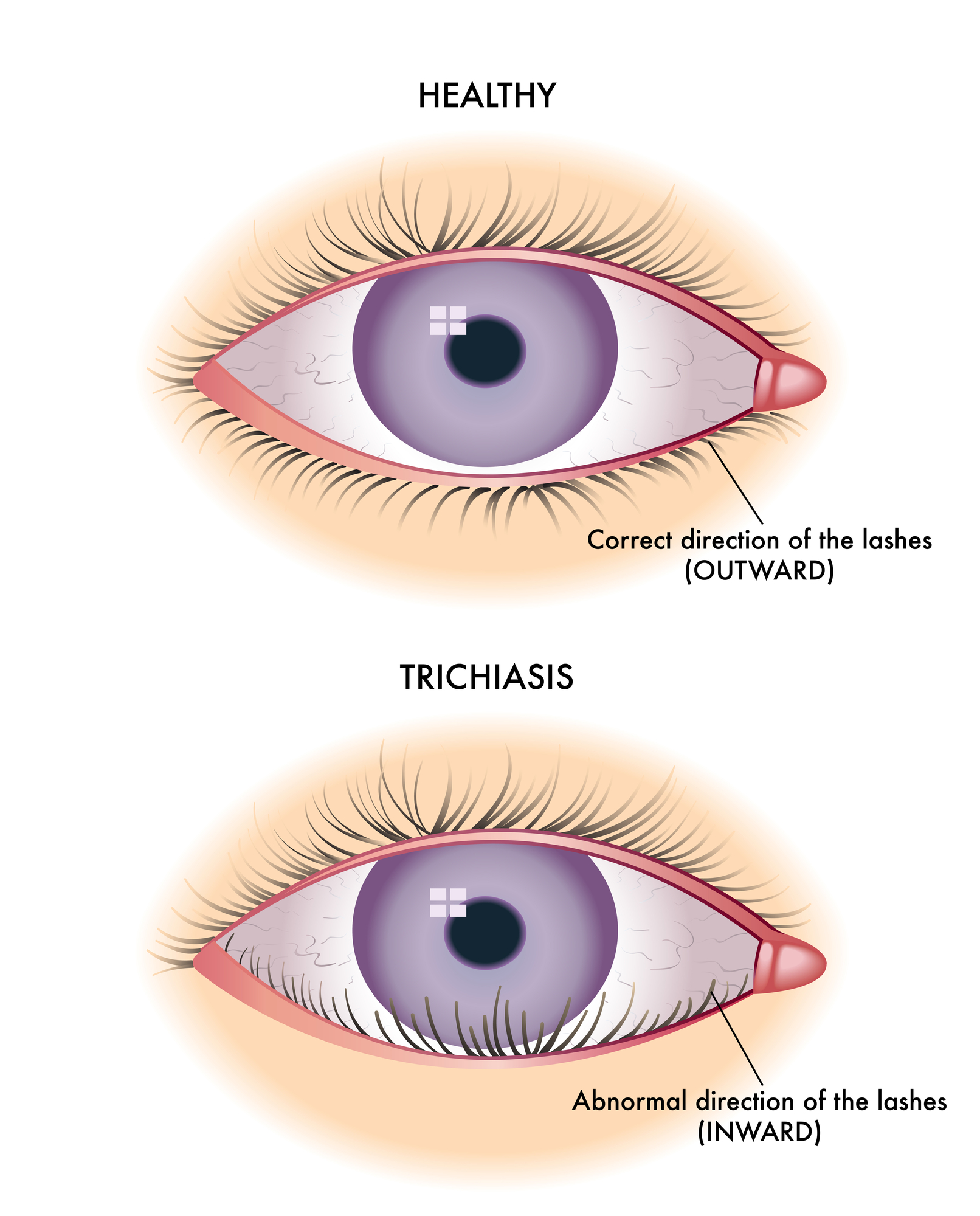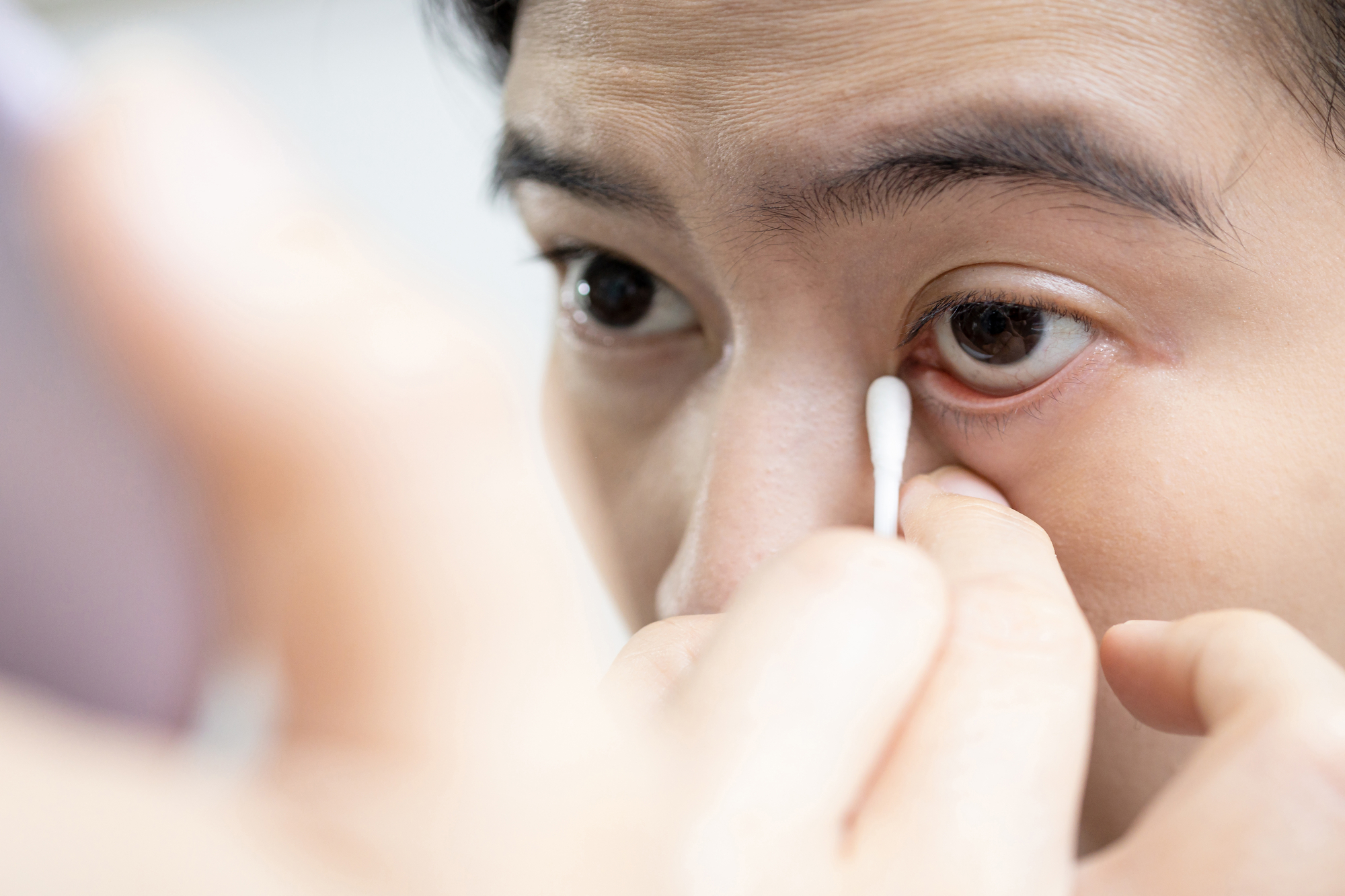Updated on October 21, 2024
Ingrown Eyelash: Causes & How to Treat It


Vision Center is funded by our readers. We may earn commissions if you purchase something via one of our links.
An ingrown eyelash (trichiasis) grows inwards instead of outwards. It can rub against the eyeball and surrounding skin, causing eye irritation and discomfort.
Left untreated, an ingrown eyelash can scratch the cornea (clear front layer of the eye), potentially causing a corneal abrasion or ulcer.

Ingrown eyelashes are more common in adults than children and can affect the upper and lower eyelids.1
While you can remove an ingrown eyelash at home, it’s not a permanent solution. Eyelashes tend to grow back at least every three months. You must seek professional assistance for a more permanent solution.
Ingrown Eyelash Symptoms
The main symptom of ingrown eyelashes is eyelashes growing in the wrong direction.

As ingrown eyelashes rub against your eyes, you may experience the following symptoms:
- Eye pain irritation
- Irritated eyelids
- Eyelid swelling and inflammation
- Watery eyes
- Itchy eyes
- Red eyes
- Sensitivity to light (photophobia)
- A gritty feeling in your eyes
- Eye infections (stye-like bump on the edge of the eyelid)
- Eye discharge (mucus or pus)
- Blurry vision
- Vision loss (in extreme cases)
You risk serious eye damage or vision loss if the above symptoms persist without intervention.
What Causes Ingrown Eyelashes?
Scientists have identified several causes of abnormal eyelash growth. However, some cases have unknown causes.
Common causes include:
- Irregular eyelash growth. Some eyelashes grow inwards naturally. Some people are born with the condition, while others develop ingrown eyelashes later.
- Eye injury or trauma. Some eye injuries lead to scar formation, which may cause the eyelashes to grow inwards.
- Entropion. This condition causes eyelids to turn inwards. As a result, eyelashes can also grow inwards.
- Chronic blepharitis. This is a condition that causes itchy, irritated, and swollen eyelids. It can make eyelashes grow in the wrong direction.3
- Trachoma. Caused by Chlamydia trachomatis, this condition may cause eyelid scarring, which can affect proper eyelash growth.
- Herpes zoster ophthalmicus (eye shingles). Swelling and rashes on the eyelids may scar, causing the inward growth of eyelashes.
- Eye surgery. Like eye trauma, the scar tissue that develops after eyelid surgery can cause eyelashes to grow in the wrong direction.
- Epiblepharon. This eyelid abnormality involves the folding of the skin near the eyelid margin. It can misdirect the growth of eyelashes.
- Distichiasis. This is a rare disorder characterized by an extra row of eyelashes. The eyelashes may grow inwards.
- Eyelid psoriasis. This condition can cause an overgrowth of skin cells on the eyelids, pushing the eyelashes in a different direction.
- Eye stye. Those prone to styes from childhood have an increased risk of developing ingrown eyelashes during adulthood.
- Aging. Aging skin can become thinner and less firm. This can cause eyelids to roll inwards, pointing eyelashes towards the cornea.
Listen In Q&A Format
Ingrown Eyelash Causes How To Treat It
Vision Center Podcast
When to See a Professional for Ingrown Eyelashes?
You should seek treatment if your ingrown eyelash is causing severe pain and discomfort, affecting your quality of life. Your doctor will advise you on various treatment options, including home remedies to relieve symptoms.
Diagnosis & Treatment of Ingrown Eyelashes
Diagnosing ingrown eyelashes isn’t always easy. Unlike cases where the eyelashes are thick, dark, and visible, some may be nearly invisible. For this reason, you’ll need an in-depth eye exam to ensure a correct diagnosis.
Ingrown eyelash treatment will depend on the extent of trichiasis and the type of lashes involved.
Common treatments include:
- Epilation. This involves plucking the eyelashes with forceps. However, it’s not permanent since hair can grow back.4
- Electrolysis. This uses mild electric current to destroy the misdirected lash follicles.5 It aims to prevent those lashes from regrowing, but regrowth is still possible.
- Eyelid surgery (Blepharoplasty). This surgery lifts the eyelids to redirect the lashes. Doctors may suggest eyelid surgery in severe cases of trichiasis.
- Radiofrequency ablation. This is the permanent removal of ingrown eyelashes and their follicles using lasers or radio frequencies.6
- Cryosurgery. In this surgery, ingrown eyelashes are frozen and removed with liquid nitrogen. However, the procedure poses a risk of blistering and scarring.
- Buccal membrane graft. During this procedure, a small portion containing the ingrown eyelash is removed and replaced with a buccal membrane graft to prevent scarring.7
- A bandage contact lens. This might be used to protect the eyeball and allow it to heal after damage by ingrown eyelashes.
- Antibiotics. These help resolve bacterial infections caused by an ingrown eyelash.
Home Remedies for Ingrown Eyelashes
If you have irritation or pain from ingrown eyelashes, there are some steps you can take at home to provide some relief:
- Flush the irritated eye with appropriate eye drops
- Apply a lubricating ointment on the affected eyelashes to soften them
- Apply a warm, wet towel to the eye to help relieve pain and inflammation
- Apply tea tree oil, which has antifungal, antibacterial, and anti-inflammatory properties8
Always consult your doctor on the best over-the-counter (OTC) options for your situation.
Preventing Ingrown Eyelashes
Some causes of ingrown eyelashes, like aging, are not preventable. Fortunately, you might be able to reduce the risk of developing them and associated infections by:
- Visiting a dermatologist if you have certain skin conditions, such as psoriasis, which can affect the eyelids9
- Keeping your hands and fingers out of your eyes
- Washing your hands before touching your eyes
- Removing makeup on your eyelashes and around your eyes before sleeping
- Maintaining good eye hygiene
- Washing your hands before placing or removing contacts
Outlook
While you can’t prevent naturally occurring ingrown eyelashes, you can take steps to prevent bacterial infections that cause them.
For example, removing eye makeup before bed helps prevent infections that can cause eyelashes to grow inwards.
Leaving trichiasis untreated can also lead to more complications later on, including vision loss. However, the outlook is positive since many treatment options are available.
Summary
- An ingrown eyelash grows inwards instead of outwards.
- The eyelash may rub against the eyeball and surrounding skin, causing eye irritation and discomfort.
- Common causes include eye infections, injury, certain chronic conditions, and eye surgery.
- Common treatments include surgery, epilation, electrolysis, radiofrequency ablation, and cryosurgery.
- Home remedies for ingrown eyelashes include warm compresses, flushing the eyes, and applying lubricants, among others.
- You should seek treatment if an ingrown eyelash affects your quality of life.
In this article
9 sources cited
Updated on October 21, 2024
Updated on October 21, 2024
About Our Contributors
Vincent Ayaga is a medical researcher and seasoned content writer with a bachelor's degree in Medical Microbiology. Specializing in disease investigation, prevention, and control, Vincent is dedicated to raising awareness about visual problems and the latest evidence-based solutions in ophthalmology. He strongly believes in the transformative power of ophthalmic education through research to inform and educate those seeking knowledge in eye health.
Dr. Melody Huang is an optometrist and freelance health writer with a passion for educating people about eye health. With her unique blend of clinical expertise and writing skills, Dr. Huang seeks to guide individuals towards healthier and happier lives. Her interests extend to Eastern medicine and integrative healthcare approaches. Outside of work, she enjoys exploring new skincare products, experimenting with food recipes, and spending time with her adopted cats.

